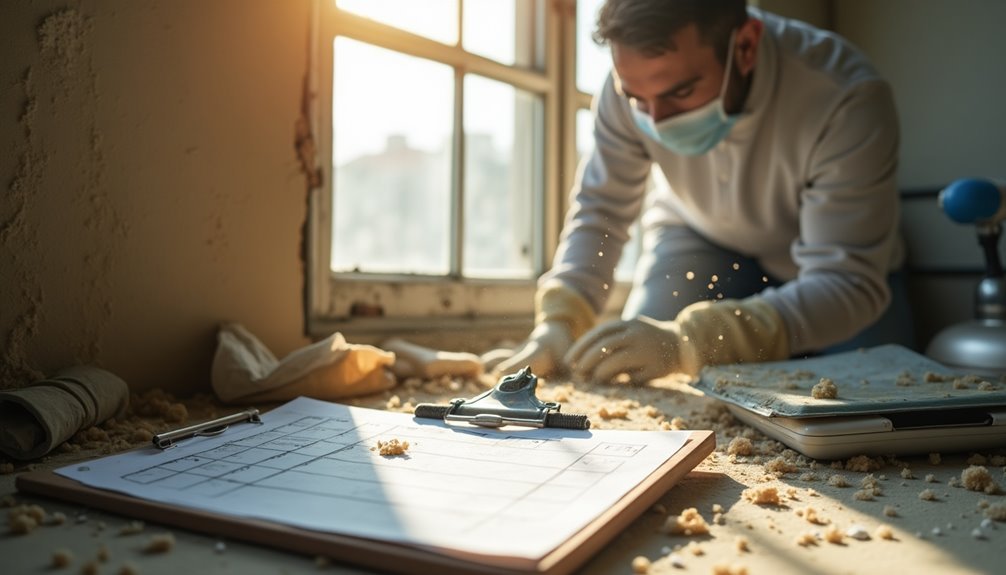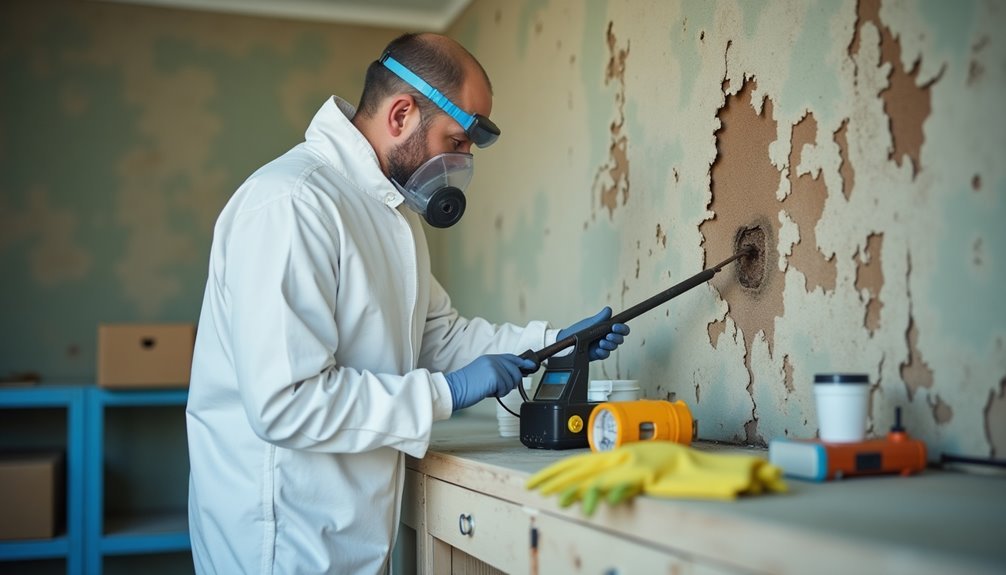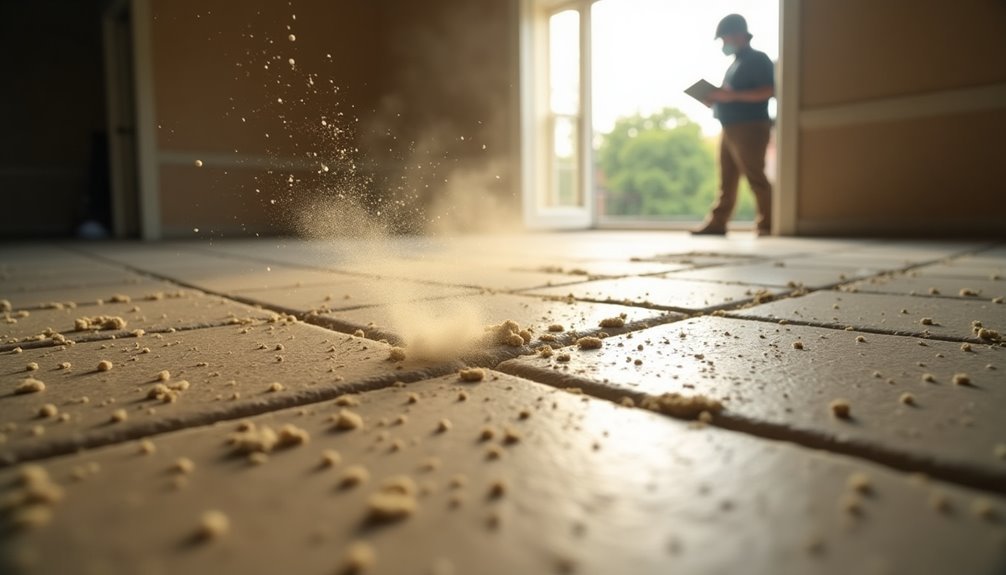To identify asbestos in your property, rely on professional testing due to its complexity and health risks. Trained specialists use methods like Phase Contrast Polarized Light Microscopy (PLM) and Transmission Electron Microscopy (TEM) to analyze samples accurately. They adhere to stringent protocols for safe and efficient sample collection, minimizing exposure risks. Such thorough testing ensures compliance with regulatory standards and provides clear lab reports detailing asbestos types and concentrations. By engaging professionals, you secure informed decision-making for remediation strategies, safeguarding your health and property. To discover more about the importance of these processes, you'll find valuable insights ahead.
Understanding Asbestos Identification Methods

How can you effectively identify asbestos in various materials? You'll need to employ specific identification techniques that focus on examining asbestos fibers. One common method is Phase Contrast Polarized Light Microscopy (PLM), which allows you to observe the long, fibrous structures of asbestos. This technique uses index-matching liquids to distinguish fibers based on their refractive indices, although it doesn't differentiate between asbestos and non-asbestos fibers.
For a more comprehensive analysis, Transmission Electron Microscopy (TEM) is beneficial. This technique can detect very fine fibers, even those smaller than 0.1 µm, and analyzes the chemical composition and crystal structure. Scanning Electron Microscopy (SEM) offers a faster, cost-effective alternative, allowing field applications and delivering results more quickly than TEM. SEM is particularly effective for detecting fine asbestos fibers undetectable by light microscopy.
Additionally, you can utilize X-Ray Diffraction (XRD) and Infra-red Spectroscopy (IRS) for identifying asbestos based on crystalline structure and chemical composition, respectively. Each method has its strengths and limitations, so selecting the appropriate identification technique ensures accurate results when assessing potential asbestos-containing materials.
Importance of Professional Testing
When it comes to asbestos testing, relying on professional services is crucial for accurate sampling techniques. Professionals are trained to comply with strict regulations, ensuring that the testing process meets all necessary legal standards. This not only protects your health but also safeguards you from potential legal issues down the line. Moreover, early identification of asbestos presence allows for timely remediation actions that can prevent serious health complications.
Accurate Sampling Techniques
In the realm of asbestos identification, employing accurate sampling techniques is vital to ensure safe and effective results. Trained professionals follow strict sampling protocols when collecting samples from potential "hot spots," such as insulation materials, tiles, and popcorn ceilings. They utilize methods like swiping or brushing surfaces and taking bulk samples from materials, ensuring that the hazardous material is handled safely.
These professionals collect samples from various areas throughout the property, providing comprehensive testing to avoid missing any potential asbestos sources. Improper sampling can disturb asbestos fibers, posing health risks to you and others in the vicinity. Once collected, samples are sent to accredited laboratories for analysis, where techniques like Polarized Light Microscopy (PLM) and Transmission Electron Microscopy (TEM) assess testing accuracy.
PLM identifies different types of asbestos, while TEM offers precise analysis, particularly for low asbestos content. The lab's comprehensive report details the areas tested, types of asbestos found, and their concentrations, allowing you to make informed decisions regarding asbestos management. Accurate sampling and laboratory analysis are essential for determining necessary actions for health safety and compliance.
Compliance With Regulations
Accurate sampling techniques not only ensure the safe handling of asbestos but also align with regulatory requirements that mandate professional testing. As a property owner or contractor, adhering to asbestos regulations is crucial before any renovation, demolition, or repair work. Certified asbestos inspectors must conduct thorough surveys to identify potential asbestos-containing materials (ACM), and these inspections are non-negotiable—failure to comply can lead to serious legal and financial repercussions.
You need to maintain a compliance checklist that includes submitting the survey results to local government entities and keeping them accessible on-site. Specific state regulations, such as those in California and New York, reinforce these requirements, leaving no room for exceptions based on a building's age.
Moreover, compliance with EPA and OSHA standards is essential, as these regulations dictate the methods for handling asbestos safely and effectively. Ignoring these guidelines can result in penalties, enforcement actions, and increased liability. By investing in professional testing, you not only safeguard health and safety but also protect property values and avoid costly legal issues down the line.
Safe Sample Collection Techniques

How can you ensure the safe collection of asbestos samples? First, assess health risks by considering the material's condition and ensuring that only trained personnel handle the process. Equip yourself with appropriate personal protective equipment (PPE), including a compliant respirator and disposable coveralls.
Before sampling, shut down HVAC systems to minimize fiber spread and isolate the area to prevent unauthorized access. Use wetting techniques, like applying a fine mist of water with detergent, to reduce fiber release during sample preparation. Employ specialized tools to extract a small representative sample, ideally the size of a 50-cent coin, ensuring you include all material layers.
Here's a quick reference table to guide you through safe sampling techniques:
| Step | Action |
|---|---|
| Assess Health Risks | Evaluate the material's condition and potential hazards. |
| Equip PPE | Wear a respirator and coveralls. |
| Wet the Material | Use water with detergent to minimize fiber release. |
| Seal and Label Samples | Place samples in airtight containers and label them. |
| Clean Up | Use HEPA vacuums and dispose of waste properly. |
Following these techniques helps ensure contamination prevention throughout the sampling process.
Lab Analysis of Asbestos Samples
In lab analysis of asbestos samples, various analytical techniques like Polarized Light Microscopy and Transmission Electron Microscopy are crucial for accurate identification and quantification of asbestos fibers. Ensuring precise results protects both health and complies with regulatory standards, making the reporting of findings essential for informed decision-making. Understanding the implications of your results can significantly impact remediation strategies and safety protocols.
Analytical Techniques Used
Asbestos identification relies on various analytical techniques to ensure accurate results in lab analysis. These methods are crucial for effective asbestos testing and help determine the type and structure of asbestos fibers present in a sample. Here are some essential analytical methods employed in the process:
- Phase Contrast Polarized Light Microscopy (PLM): Identifies asbestos fibers based on their optical properties and morphology.
- Transmission Electron Microscopy (TEM): Provides detailed analysis of fiber dimensions and chemical composition, even for very fine fibers.
- Stereo-Microscopy: Offers a three-dimensional view of samples for preliminary identification before detailed analysis.
- Scanning Electron Microscopy (SEM): Analyzes asbestos in air and dust samples, crucial during removal work.
- X-ray Diffraction (XRD) and Infra-red Spectroscopy (IRS): Used to identify specific asbestos minerals, complementing other techniques.
Each of these analytical methods plays a significant role in confirming the presence of asbestos. By understanding these techniques, you can appreciate the complexity and necessity of professional testing in ensuring safety and compliance regarding asbestos exposure in your property.
Importance of Accurate Results
Ensuring accurate results in lab analysis of asbestos samples is critical for safeguarding health and compliance with regulations. When you engage certified inspectors for asbestos testing, you benefit from their expertise and specialized equipment, which significantly reduces the risk of contamination and inaccurate results. Accredited laboratories, like those endorsed by the National Voluntary Laboratory Accreditation Program (NVLAP), provide an additional layer of assurance that testing meets stringent standards.
Accurate results from professional testing enable early detection of asbestos, allowing prompt action to mitigate health hazards such as asbestosis and lung cancer. By identifying the presence of asbestos, you can minimize exposure to harmful fibers and implement appropriate management strategies to prevent long-term health effects. Furthermore, compliance with legal and regulatory standards not only protects you but also the public, ensuring safe handling of asbestos-containing materials.
Ultimately, accurate results foster peace of mind, allowing you to make informed decisions about your property. The importance of professional involvement in asbestos testing cannot be overstated, as it lays the groundwork for health protection, legal compliance, and property value assurance.
Reporting Findings and Implications
Lab analysis of asbestos samples culminates in a comprehensive reporting process that provides critical insights into the presence and types of asbestos found. Ensuring documentation accuracy and adherence to reporting standards is crucial for effective communication of findings. Once the analysis is complete, professionals generate a detailed report outlining:
- Areas tested and samples collected
- Types of asbestos identified and their concentration
- Compliance with regulatory frameworks like HSG 248
- Recommendations for potential abatement actions
- Database records for traceability and future reference
These reports serve as essential documents for property owners and regulatory bodies, detailing whether asbestos is present and the implications for health and safety. The findings guide the development of an asbestos abatement plan if necessary, emphasizing the importance of professional intervention. Remember, early detection can significantly reduce health risks associated with asbestos exposure, such as asbestosis and mesothelioma. Post-report actions may include follow-up testing to ensure a safe environment post-abatement. By prioritizing thorough reporting and documentation, you empower yourself to make informed decisions regarding asbestos management.
Comprehensive Reporting and Documentation

Comprehensive reporting and documentation play a crucial role in the effective management of asbestos-related risks. When you conduct an asbestos survey, you need to include the scope of the survey, the requester's details, and a thorough description of the property. Document the date and time of inspections, along with the qualifications of the inspector. Your inspection reports must clearly outline findings and results, detailing the methods used to assess asbestos levels.
In addition, summarize inspection results in a table, listing all suspect materials tested and noting those that tested positive for asbestos. Include assessments of each material's description, location, condition, and percent asbestos content, specifying whether materials are friable or non-friable.
It's essential to comply with regulations regarding sampling methods and laboratory analysis. Ensure that your report has a documented chain of custody and includes certified lab analysis results. Attach diagrams and photographs to substantiate your findings. Finally, require a Cal/OSHA Certified Asbestos Consultant's wet signature to validate the report's accuracy, and submit it to local government entities while keeping it accessible on-site during the project.
Health Risks Associated With Asbestos
As you manage asbestos-related risks, it's vital to understand the serious health implications associated with asbestos exposure. Inhaling asbestos fibers can lead to severe lung diseases, with symptoms often taking 20 to 50 years to surface. Early signs may include vague asbestos symptoms such as coughing or shortness of breath, which could indicate more significant issues down the line.
Consider the following health risks linked to asbestos exposure:
- Asbestosis: Scarring of lung tissue from inhaled fibers.
- Mesothelioma: A rare cancer affecting the lung lining, predominantly caused by asbestos.
- Lung cancer: Increased risk, especially for smokers.
- Digestive system cancers: Elevated chances of cancers like colon cancer.
- Nonmalignant pleural disorders: Conditions like pleural plaques and thickening.
Asbestos fibers can become airborne and, once inhaled, lodge deep in your lungs, causing chronic inflammation and scarring. Even minimal exposure can pose a significant risk, making it essential to identify and manage asbestos hazards effectively. Remember, protection starts with knowledge and professional testing to ensure a safer environment for you and your loved ones.
Strategies for Preventing Asbestos Exposure

Effective strategies for preventing asbestos exposure hinge on proactive measures and rigorous protocols. First, avoid disturbing any suspected asbestos-containing materials until you've implemented proper assessment and control steps. During renovation or demolition, always use safe renovation practices like wetting materials to minimize airborne fibers. Never smoke, eat, or drink in areas where asbestos exposure is possible, and ensure all workers wear appropriate personal protective equipment, including NIOSH-approved respirators.
Identification is crucial; use signs and labels to clearly mark areas with potential asbestos risk. Inform your team of any known asbestos locations and look for visual indicators such as textured ceilings or old insulation. However, remember that visual cues aren't definitive; professional testing is essential.
Maintaining cleanliness also plays a vital role in asbestos prevention strategies. Use wet cleaning methods and HEPA vacuums to limit dust spread, and always change clothes before entering your home. On windy days, keep windows closed to prevent fiber intrusion. By adhering to these strategies, you can significantly reduce the risk of asbestos exposure and protect your health and that of others around you.
Conclusion
As you navigate the labyrinth of your property, think of asbestos as a hidden dragon, lurking in the shadows. Only through the expertise of professional testing can you unveil its presence and ensure your safety. Just as a skilled knight uses a map to conquer perilous terrains, a certified expert employs advanced techniques to identify and mitigate risks. Don't let uncertainty reign; arm yourself with knowledge, and protect your domain from the dangers of asbestos exposure.
